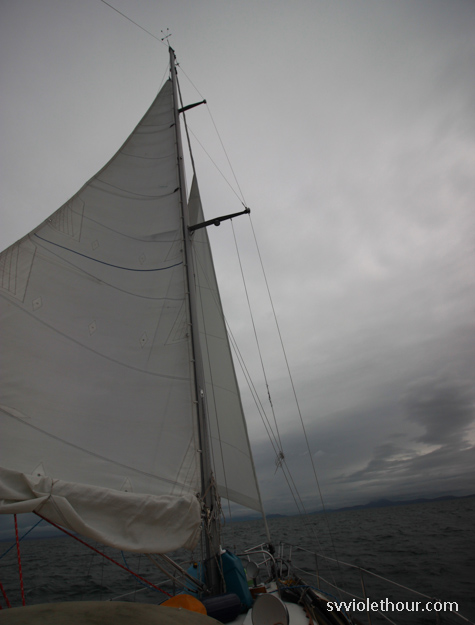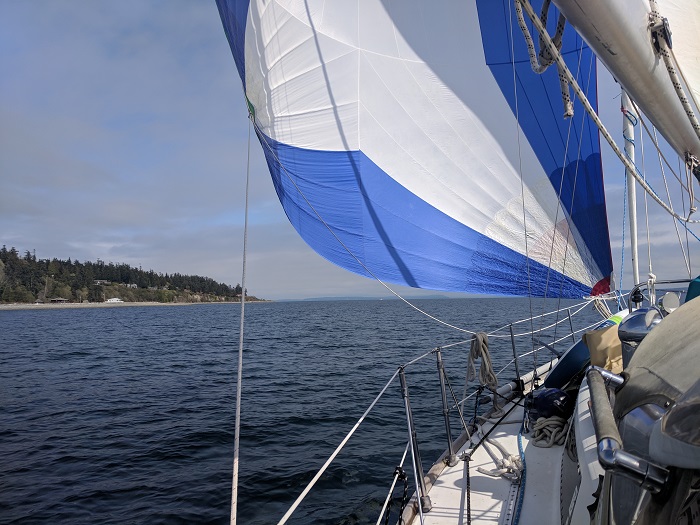It’s easy to forget how difficult sailing in the Pacific Northwest can be. We’ve been underway a week and a half now, and made a slow escape from Puget Sound. Every couple days a different weather system has been coming through, and interpreting the forecasts has been incredibly difficult.
We first sailed south to Blake Island, and had a few southerly gales while there (bringing pounding rain and graupel at times too!). Then we had only light wind going north to Port Madison (S 6-8) and then Port Ludlow (S 4-12 and N 12). The next day, en route to Port Townsend, brought N 18-25 with a gale warning for the evening (we left at 7am to beat it!).
Part of the challenge has been weather patterns that are completely different from one area of Puget Sound to another. On some days there’s been south wind at Seattle but north wind at Port Townsend, or vice versa, and a small craft advisory at one but no wind at the other. Another difficulty we’ve found is the NOAA forecast has often been wrong in wind magnitude or direction, or both.
Fortunately the ECMWF model (European) in Windy has been pretty accurate (more so than NAM, the North American model).


This goose at Blake Island hung out with the Canadian geese but looked nothing like the others. Anyone know if it’s a different species or some sort of albino Canadian goose?

The Canadian geese didn’t give two hoots about the raccoon (which got on our boat only once).
Docking Challenges
It always amazes me how after 4 years of cruising on our boat, and more on others, docking is still something I mess up sometimes. How is it that docking is one of the hardest things in cruising?
We were coming into the commercial basin at Port Townsend Boat Haven and it was blowing NW 15-18 outside but just about NW 10-12 in the marina. But the commercial basin has really tight fairways and the slips are aligned crosswise (perpendicular) to the wind. Our boat is tough to maneuver with wind on the beam, tending to slide sideways.
Our dock was port side tie, leeward, and I overshot by a couple feet too much (better to overshoot than undershoot, when docking on a leeward dock) and started heading into our neighbor’s stern. Hard reverse kept us from that calamity, but stopping our forward momentum meant the north wind pushed us sideways and now I was undershooting the dock.
I managed to get the front half of the boat into the slip, which meant our stern was being pushed south by the wind and trying to crunch our beam into the corner of the dock. I was able to push it off and get us in, but it definitely was one of our less elegant dockings!
Crossing the Strait of Juan de Fuca
Wednesday we knew we had just about the perfect forecast for sailing across the JdF (Juan de Fuca) – SE 10-20 according to Windy’s ECMWF model. Or according to NOAA, SE 10-20 building to SE 15-25 in the afternoon. The ECMWF had the wind shutting down to less than 10 after noon, a big conflict with NOAA’s forecast, so we trusted the European model since it’s been getting everything right lately. We took off early (7am) to use the wind before noon – and good thing we did because ECMWF won out over NOAA again!

Mid-strait in pretty nice, flatter wave state. Still doing 6.5-7 kts.
We had a great, albeit rowdy, sail across the strait. Around 10am it picked up to 20 knots gusting 25 so we reefed the main and double reefed the genoa. We were doing 8 knots before reefing and still 7 knots after reefing (but much easier helming), so it was a good call.
This gave us a chance to give our new autopilot its first real test. We used it during reefing, which is very helpful when double-handing because otherwise the two of us have to do three jobs simultaneously. The waves were close-spaced Point Wilson washing machine waves, and we were overpowered for sure, surfing down waves at 8 knots. Ie., terribly hard conditions for an autopilot. But it performed splendidly, keeping us on a 150 degree broad reach even as we rolled rapidly from –15 degrees to +5 in the span of 4 seconds.

Things got better after that, but we knew they’d get bad again at Rosario Strait as we made our way to Watmough Bay. A consequence of leaving early to use the southerly wind was we were 3 hours too early to Rosario, hitting it a max ebb – wind against current. 3 knots of current against 15-20 of wind made for some impressively awful waves.
These were clearly worse than the Point Wilson ones. 4-5 feet close spaced and confused, rolling our boat from beam to beam at any angle we headed. Fortunately this only lasted about 45 minutes and then we were in to Watmough, as the rain started and the wind dropped.
Coming Up
We’re hanging out in the San Juans for a couple weeks and then crossing into BC somewhere in the Gulf Islands. So far our first ten days of April have been a bit tougher weather-wise than last year’s April! Here’s to hoping the second half of April will have a bit more sun.

We flew the spinnaker for the first time this year, on a light day going from Port Madison to Port Ludlow

“How is it that docking is one of the hardest things in cruising?”
Well if you were a pilot you’d say landing is one of the hardest things, and that folks still mess it up occasionally even after 4 years of flying. Seems to have something to do with transitioning a vehicle from one state to another, different conditions every time, and brain/hand coordination not adapting quickly enough…
Though both have their challenges, docking’s usually worse than anchoring. So many factors. Linda, who typically helms the boat while docking when we’re both aboard, calls out wind and current conditions to her crew just before we get to the slip. That way, I’m prepared for the direction in which things MIGHT go sideways. We’ve always taken comfort from the counsel of commercial captains who tell us in humility that they screw up regularly, and that’s what keeps them aware. After we land, there are two things we look for: flowing blood or broken bones. In their absence, we state the case, congratulate each other on a job well-done and debrief over a pleasing beverage.
I reckon everyone still stresses out about docking every now and then. I had a real allergy to marinas for a while there. I find reversing in right from the very end of the dock and avoiding any three point turns in tight places is working for me at the moment. Good luck and happy sailing. Looking forward to following your adventures. Autumn is well and truly in full swing down here in NZ!
Good to hear from you Viki! Autumn in NZ sounds pretty. We’ll have to get back someday.
I would be interested to hear what autopilot y’all selected; I also have a 37′ boat in need of one. I’ll stay tuned.
I’m going to do a couple articles on it as soon as I can. It’s a Raymarine Evolution / ACU-200.
Michelle says it is a domestic goose that somehow made its way to Blake.